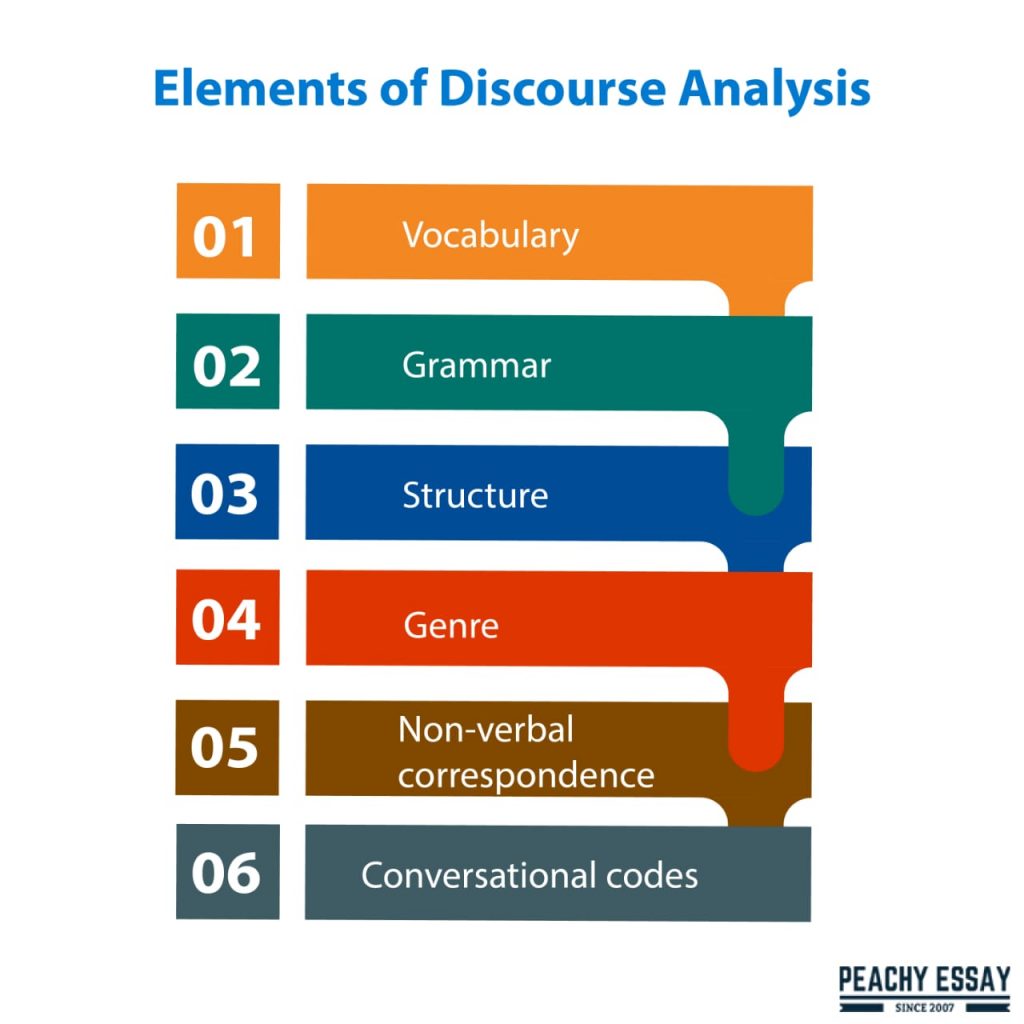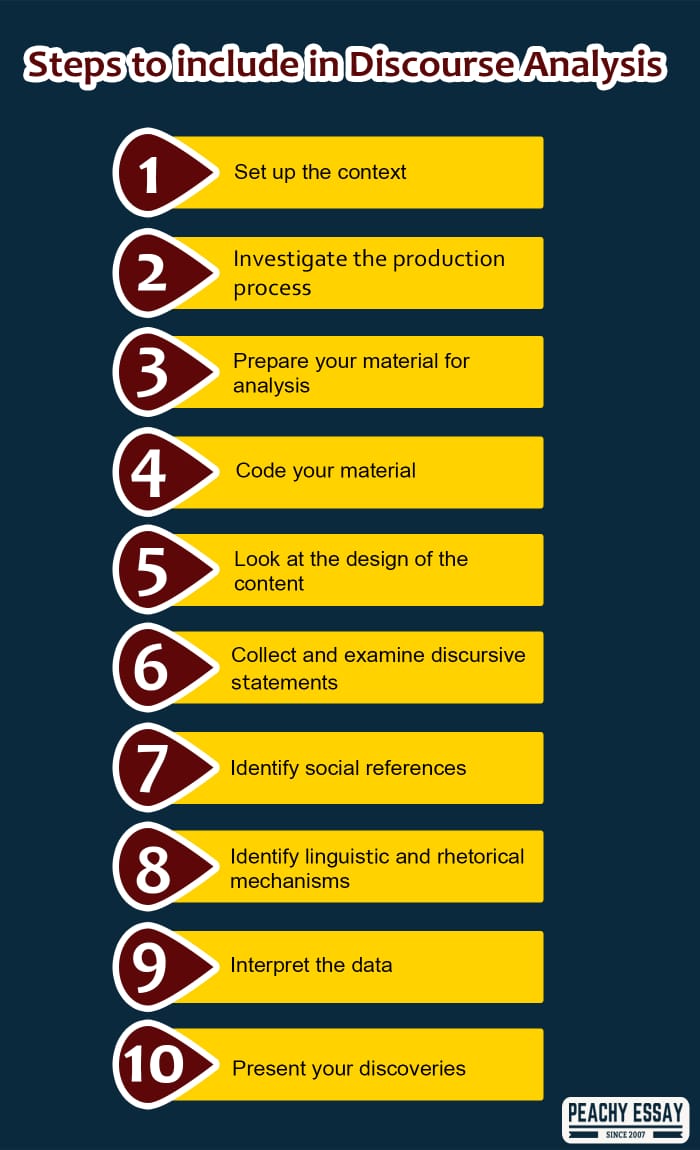Qualitative research regularly centres on different aspects, such as interviews, focus groups, journals, web-based media or records. Subjective analysts frequently attempt to comprehend the world by tuning in to how individuals talk; however, it may be truly uncovering to take a look at what individuals say and how they do it. Basically, this is the way discourse analysis (DA) can be utilized to inspect subjective information.
Discourse is the finished framework by which individuals convey the most extensive understanding of what we call ‘language’. It incorporates composed, verbal, and non-verbal correspondence and the more extensive social ideas supporting what language means and how it changes. For instance, it uncovers how a few groups utilize a specific word or terms from a specific neighbourhood tongue. This can show their childhood and life history, or impacts from others and work environment culture.
In this article, you will get in-depth information about discourse analysis and steps for conducting it.
What is Discourse Analysis?
Discourse analysis is a subjective investigation technique, which investigates the implications delivered by language use and correspondence, the specific situations, processes of these implications, and practices brought about by these implications. Discourse analysis intends to see and classify different significance making cycles, organizations and practices from the information. Discourse analysis, as an investigation practice, incorporates different beginning stages and order explicit applications.
Uses of Discourse Analysis
Discourse analysis suggests taking a look at the capacity of language and how important is made in different group environments. It might be applicable to any made or oral language and non-verbal pieces of communication, similar to tone and signals.
Here are the materials that are reasonable for talk investigation:
- Books, papers, and periodicals
- Promoting material, similar to flyers and advertisements
- Business and government files
- Sites, get-togethers, online media posts, and comments
- Interviews and conversations
By analyzing these sorts of talk, analysts intend to fathom gatherings of individuals and how they impact
How is Discourse Analysis Different from other Methods?
Dissimilar to phonetic methodologies that focus on rules, discourse analysis underscores language’s context-oriented importance.
It centres on the social parts of correspondence and utilises language to accomplish explicit impacts (e.g., building trust, making uncertainty, particles, or etc.).
Instead of focusing on more unassuming units of language, similar to sounds, words, or articulations, discourse analysis is used to inspect greater bits of language, similar to entire conversations, works, or varieties of compositions. The picked sources can be analyzed on various levels.
Components of Discourse Analysis
Here is the thing that is inspected under talk investigation.

Vocabulary
Words and expressions can be dissected for philosophical affiliations, custom, and indirect and figurative substance.
Grammar
How sentences are built (for example, action-word tenses, dynamic or uninvolved development, and the utilization of objectives and questions) can uncover parts of the proposed meaning.
Structure
The construction of a book can be investigated for how it makes accentuation or fabricates a story.
Genre
Writings can be dissected about their kind’s shows and informative points (such as political discourses or newspaper articles).
Non-verbal correspondence
Non-verbal parts of the discourse, like manner of speaking, stops, signals, and seems like “um”, can uncover parts of a speaker’s goals, perspectives, and feelings.
Conversational codes
The collaboration between individuals in a discussion, for example, turn-taking, interferences and audience reaction can uncover social conventions and social roles.
Discourse Analysis Steps
Here are the steps the discourse analysis steps

Set up the context
Before you start dealing with your source material, record the origin of the material. It very well may be ideal on the off chance that you asked yourself the social and certain setting wherein your sources were conveyed. Write down your source’s language, its original country, author, and publisher.
Moreover, endeavour to record when and how you found your sources and explain where others may find copies. Finally, choose if your sources are responses to any critical event, if or not they tie into more broad conversations, and how they were gotten at the hour of conveyance.
Investigate the production process
You have viably recorded who formed and published your sources; notwithstanding, you really need to do a more serious individual examination. Endeavor to find additional information on the producer of your source material and their organizational and personal establishment. For example, on the off chance that you are conveying news, explore such a paper that the articles are from, who are the essayist and the publication employees, what is the general political circumstance of the paper, and what is its coalition with various affiliations? Are any people drawn in with the creative collaboration known for their article style or political points of view? Is there any information on the inventive uses and general assets of the paper? Do you know who the general target horde of the paper is?
By and large, news sources themselves give a portion of this data on the web, for example, in the “about” segments of their sites. In different cases, you will discover such data in optional scholastic writing. Try not to stop for a second to compose the editors an email or hit them up: individual meetings can be an extraordinary method to investigate creation foundations.
Prepare your material for analysis
To analyze the genuine content, you need to set it up such that it will allow you to work with the source and make careful references later. On the off chance that you are working with a printed duplicate, make a couple of additional copies of your source material to form on these adaptations and mark significant features. On the off chance that you haven’t, as of now, endeavour to digitize your source or get an electronic copy. Add references to enable others to be the followers of your work later: incorporate numbers for lines, headers, areas, figures, or whatever different features will assist you to maintain your course.
Code your material
When you code information, it implies that you are allocating qualities to explicit units of examination, like sections, sentences, or individual words. Kindly consider the number of us label online data like pictures, connections, or articles. Coding is basically a scholarly form of this labelling cycle.
For example, you may be examining an official discourse to perceive what globalization talk it draws from. It bodes well to check all discourse proclamations that manage globalization and its connected subjects (or talk strands). Before you start with this cycle, you need to think of your coding classifications.
The initial step is to diagram a couple of such classifications hypothetically: in light of the sort of inquiry you are posing and your insight into the topic, you will as of now have a couple of key subjects as a top priority that you hope to discover, for example, “exchange”, “relocation”, “transportation”, “correspondence, etc. An intensive survey of the auxiliary writing on your subject will probably offer motivation. Record your first contemplations, and record subjects that you think may identify with these key topics. These are your beginning classes.
Look at the design of the content
After organizing your materials and having coded the discussion strands, you have the opportunity to investigate the compositions’ essential features. Are there portions that overwhelmingly oversee one talk? Are there habits by which assorted talk strands cover the substance? Check whether you can perceive how the dispute is coordinated: does the substance go through a couple of issues separately? Does it first make a counter-genuine case to invalidate that case and make the guideline conflict? Presently, you should similarly consider how the headers and other configuration features control the dispute and which work the introduction and end play in the overall arrangement of things.
Collect and examine discursive statements
When you have a brilliant thought about your content’s full-scale features, you can zero in on the individual clarifications or talk parts. A nice strategy to do this is to accumulate all attestations with a specific code and take a look at what they need to say on the different talk strand. This combination of verbalizations will allow you to layout what “surenesses” the substance sets upon each critical point.
Identify social references
Consider how the setting enlightens the conflict. Is your material containing references to various sources or recommend data on a different subject? What importance does the substance property to such various sources? Examining these requests will assist you to figure out which work intersexuality serves, thinking about the overall dispute.
Identify linguistic and rhetorical mechanisms
The subsequent stage in your investigation will likely be the most arduous and the most illuminating with regards to investigating how talk functions in detail. It would help if you recognized how the different articulations work at the degree of language. To do this, you may need to utilize extra duplicates of your content for each work-step, or you may have to make separate coding classes for your computerized documents.
Interpret the data
You presently have every one of your examination components together; however, the main inquiry remains: what does everything mean? In your translation, you need to attach your outcomes to clarify the issue here and how it functions. This implies joining your insight into underlying highlights and individual articulations and afterwards putting those discoveries into the more extensive setting you set up toward the start.
All through this interaction, remember the accompanying inquiries: who made the material you are investigating? What is their situation on the theme you inspected? How do their contentions draw from and, thus, add to usually acknowledged information on the point at that point and in the spot that this contention was made? Furthermore, perhaps in particular: who may profit by the talk that your sources build?
Present your discoveries
When you answer your unique inquiry, the time has come to get your outcomes across to your intended interest group. On the off chance that you have directed a decent examination, you currently have a tremendous measure of notes from which you can fabricate your introduction, paper, or postulation.
Make a point to pressure the significance and travel through your investigation dependent on the issues you need to introduce. Continuously ask yourself: what is intriguing about my discoveries, and for what reason would it be a good idea for anyone to mind? A discussion or a paper that rundowns one talk includes after another is dreary to follow, attempting to present a convincing defence. You would then be able to add proof from your work on a case by case basis, for example, by adding unique and interpreted guides to show your point. For some scholarly papers, especially graduation propositions, you might need to aggregate the full record of your information investigation in a supplement or some other separate document with the goal that your assessors can check your work.
Types of Discourse Analysis
Like such countless cover subjective terms, there are various practices and kinds of examination called ‘discourse’ analysis and a wide range of methods of applying them.
- Formal etymological (fundamentally seeing words/expressions, language structure or semantics)
- Observational (social practice developed through text)
- Basic (language building and restricting idea)
Discourse Analysis Example
Here is a talk investigation model:
Envision the accompanying situation from your #1 anecdotal clinical dramatization. A patient is wheeled into the ER/causality unit, cognizant, however experiencing burns. The specialist attending expresses three things:
To Patient: “We’re simply going to give you a little infusion to assist with the torment.”
To Nurse: “10cc’s of sodium pentothal, stat!”
To Surgeon: “We have extreme second-degree chemical burns, GA administered.”
The specialist has said basically something very similar multiple times in the present circumstance, yet each time utilizing an alternate reaction for every beneficiary. Right off the bat, when conversing with the patient, the specialist doesn’t utilize any clinical wording and uses calming language to comfort the patient. This is an exemplary kind of talk we know about from clinical TV dramatizations.
To the nurse, the specialist has an alternate tone, seriously ordering and surprisingly deigning. It’s a yelped order, gotten done with the term ‘stat!’ – An ordinarily utilized average slang word (meaning quickly). This is fascinating because it is not a term you’d hear utilized in other expert spots like a bustling kitchen. It shows a particular talk for the setting (a medical clinic) and various individuals. The ’10cc of sodium pentothal’ is a generally utilized sedative: the equivalent ‘painkiller’ however now with a (reserved) pharmacological name and portion.
Finally, to another specialist, a similar medicine is portrayed by the specialist as a truncation (GA for General Anesthetic). Between senior wellbeing experts, shortened forms may be utilized all the more regularly, for this situation, really concealing the particular medication given, maybe on the premise that the other specialist doesn’t have to know. It could likewise suggest that since just that essential initial step has been made, there has been little appraisal or mediation up until this point.
Tips on How to Conduct Discourse Analysis
Discourse analysis is a subjective and interpretive technique for dissecting writings (contrasted with more efficient substance examination strategies). You make understandings dependent on both the subtleties of the actual material and on logical information.
You can utilize a wide range of approaches and advancements for talk examination, yet the means underneath layout the essential advances for you.
Define the examination question and choose the content of the investigation
To analyse a discourse, you start with an obviously characterized research question. Whenever you have built up your inquiry, kindly choose a scope of proper material to respond to it.
Discourse analysis is a strategy applicable both to enormous volumes of material and to more modest examples, contingent upon the points and timescale of your exploration.
Gather information and theory on the context
Then, you should set up the social and recorded setting in which the material was delivered and expected to be gotten. Assemble authentic subtleties of when and where the content was made, who the creator is, who distributed it, and whom it was spread to.
Just as understanding the genuine setting of the talk, you can likewise lead a writing audit on the subject and build a hypothetical system to direct your investigation.
For example, you research verifiable data on the’s nation’s legislative issues and history and the organizations you are examining. You likewise research hypothesis on just changes and the connection between government and business.
Analyze the substance for subjects and examples
This step includes intently analyzing different material components – like words, sentences, passages, and generally speaking construction – and relating them to properties, topics, and examples pertinent to your examination question.
For instance, you dissect the chosen material for phrasing and explanations that reflect or identify with dictator and vote based political belief systems, including perspectives toward power, liberal qualities, and prevalent attitude.
Review your outcomes and conclude
Whenever you have relegated specific credits to the material components, ponder your outcomes to look at the language’s capacity and importance. Here, you will consider your investigation of the more extensive setting you set up before to make inferences that answer your examination question.


